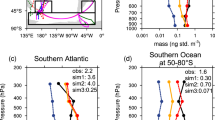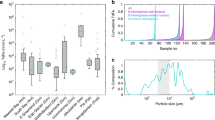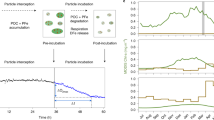Abstract
Iron limits phytoplankton growth and hence the biological carbon pump in the Southern Ocean1. Models assessing the impacts of iron on the global carbon cycle generally rely on dust input and sediment resuspension as the predominant sources2,3. Although it was previously thought that most iron from deep-ocean hydrothermal activity was inaccessible to phytoplankton because of the formation of particulates4, it has been suggested that iron from hydrothermal activity5,6,7 may be an important source of oceanic dissolved iron8,9,10,11,12,13. Here we use a global ocean model to assess the impacts of an annual dissolved iron flux of approximately 9×108 mol, as estimated from regional observations of hydrothermal activity11,12, on the dissolved iron inventory of the world’s oceans. We find the response to the input of hydrothermal dissolved iron is greatest in the Southern Hemisphere oceans. In particular, observations of the distribution of dissolved iron in the Southern Ocean3 (Chever et al., manuscript in preparation; Bowie et al., manuscript in preparation) can be replicated in our simulations only when our estimated iron flux from hydrothermal sources is included. As the hydrothermal flux of iron is relatively constant over millennial timescales14, we propose that hydrothermal activity can buffer the oceanic dissolved iron inventory against shorter-term fluctuations in dust deposition.
This is a preview of subscription content, access via your institution
Access options
Subscribe to this journal
Receive 12 print issues and online access
$259.00 per year
only $21.58 per issue
Buy this article
- Purchase on Springer Link
- Instant access to full article PDF
Prices may be subject to local taxes which are calculated during checkout



Similar content being viewed by others
References
Boyd, P. W. et al. Mesoscale iron enrichment experiments 1993–2005: Synthesis and future directions. Science 315, 612–617 (2007).
Aumont, O. & Bopp, L. Globalizing results from in situ iron fertilization studies. Glob. Biogeochem. Cycles 20, GB2107 (2006).
Moore, J. K. & Braucher, O. Sedimentary and mineral dust sources of dissolved iron to the world ocean. Biogeosciences 5, 631–656 (2008).
Elderfield, H. & Schultz, A. Mid-ocean ridge hydrothermal fluxes and the chemical composition of the ocean. Annu. Rev. Earth Planet. Sci. 24, 191–224 (1996).
Jenkins, W. J. et al. Oceanic volcanic 3He: Where is it going? Eos Trans. AGU 88 (suppl.), abstr. OS32A-02 (2007).
Dutay, J.-C. et al. Evaluation of OCMIP-2 ocean models’ deep circulation with mantle helium-3. J. Mar. Syst. 48, 15–36 (2004).
Farley, K. A. et al. Constraints on mantle 3He fluxes and deep-sea circulation from an oceanic general circulation model. J. Geophys. Res. 100, 3829–3839 (1995).
Mackey, D. J., O’Sullivan, J. E. & Watson, R. J. Iron in the western Pacific: A riverine or hydrothermal source for iron in the Equatorial Undercurrent? Deep-Sea Res. I 49, 877–893 (2002).
Boyle, E. A. et al. Iron, manganese, and lead at Hawaii Ocean time-series station ALOHA: Temporal variability and an intermediate water hydrothermal plume. Geochim. Cosmochim. Acta 69, 933–952 (2005).
Statham, P. J., German, C. R. & Connelly, D. P. Iron(II) distribution and oxidation kinetics in hydrothermal plumes at the Kairei and Edmond vent sites, Indian Ocean. Earth Planet. Sci. Lett. 236, 588–596 (2005).
Boyle, E. & Jenkins, W. J. Hydrothermal iron in the deep western South Pacific. Geochim. Cosmochim. Acta 72, A107 (2008).
Bennett, S. A. et al. The distribution and stabilization of dissolved Fe in deep-sea hydrothermal plumes. Earth Planet. Sci. Lett. 270, 157–167 (2008).
Toner, B. M. et al. Preservation of iron(II) by carbon-rich matrices in a hydrothermal plume. Nature Geosci. 2, 197–201 (2009).
Chu, N.-C. et al. Evidence for hydrothermal venting in Fe isotope compositions of the deep Pacific Ocean through time. Earth Planet. Sci. Lett. 245, 202–217 (2006).
Kinkhammer, G. P. et al. Discovery of new hydrothermal vent sites in Bransfield Strait, Antarctica. Earth Planet. Sci. Lett. 193, 395–407 (2001).
Marinov, I. et al. The Southern Ocean biogeochemical divide. Nature 441, 964–967 (2006).
Mahowald, N. M. et al. Change in atmospheric mineral aerosols in response to climate: Last glacial period, preindustrial, modern, and doubled carbon dioxide climates. J. Geophys. Res. 111, D10202 (2006).
Tagliabue, A., Bopp, L. & Aumont, O. Evaluating the importance of atmospheric and sedimentary iron sources to Southern Ocean biogeochemistry. Geophys. Res. Lett. 36, L13601 (2009).
Raiswell, R. et al. Bioavailable iron in the Southern Ocean: The significance of the iceberg conveyor belt. Geochem. Trans. 9, 1–23 (2008).
Lancelot, C. et al. Spatial distribution of the iron supply to phytoplankton in the Southern Ocean: A model study. Biogeosci. Discuss. 6, 4919–4962 (2009).
Elrod, V. A. et al. The flux of iron from continental shelf sediments: A missing source for global budgets. Geophys. Res. Lett. 31, L12307 (2004).
Smith, K. Jr et al. Free-drifting icebergs: Hot spots of chemical and biological enrichment in the Weddell Sea. Science 317, 478–482 (2007).
Parekh, P. et al. Atmospheric carbon dioxide in a less dusty world. Geophys. Res. Lett. 33, L03610 (2006).
Tagliabue, A., Bopp, L. & Aumont, O. Ocean biogeochemistry exhibits contrasting responses to a large scale reduction in dust deposition. Biogeosciences 5, 11–24 (2008).
Tagliabue, A. et al. Quantifying the roles of ocean circulation and biogeochemistry in governing ocean carbon-13 and atmospheric carbon dioxide at the last glacial maximum. Clim. Past 5, 695–706 (2009).
Lenton, A. et al. Stratospheric ozone depletion reduces ocean carbon uptake and enhances ocean acidification. Geophys. Res. Lett. 36,L12606 (2009).
Sarmiento, J. L. et al. Response of ocean ecosystems to climate warming. Glob. Biogeochem. Cycle 18, GB3003 (2004).
Baker, E. T. & German, C. R. On the global distribution of hydrothermal vent fields. Geophys. Monogr. Ser. 148, 245–266 (2004).
Johnson, K. S., Gordon, R. M. & Coale, K. H. What controls dissolved iron concentrations in the world ocean? Mar. Chem. 57, 137–161 (1997).
Johnson, K. et al. Developing standards for dissolved iron in seawater. Eos Trans. AGU 88, 10.1029/2007EO110003 (2007).
Acknowledgements
We acknowledge financial support from grant GOCE-511176 (EU FP6 RTP project CARBOOCEAN) funded by the European Commission, CNRS (France), International Polar Year GEOTRACES, the Australian Government’s Cooperative Research Centres Programme through the Antarctic Climate and Ecosystems CRC (ACE CRC) and the Australian Antarctic Division (project AAS 2900). This work was carried out using HPC resources from GENCI-IDRIS (Grant 2009-10040). We thank the captains and crew of the Aurora Australia and Marion Dufrense for their assistance at sea, A. Lenton, J. Orr, N. Flipo, W. Howard and P. van der Merwe for comments, J. K. Moore for providing the Southern Ocean sediment iron input from the BEC model and E. Butler and R. Watson for help in collecting the samples along the SR3-GEOTRACES transect.
Author information
Authors and Affiliations
Contributions
Manuscript preparation, conducting simulations and analysing results (A.T.), compiling hydrothermal iron and helium data set (P.J.-B.), project planning and experimental design (A.T., L.B., J.-C.D., P.J.-B, O.A., M.G. and C.J.), new Southern Ocean Fe observations during International Polar Year GEOTRACES (A.T., A.R.B., F.C., E.B., D.L., T.R. and G.S.), helium data/model analysis (A.T. and J.-C.D.). All authors contributed to the discussion of the results and their implications, as well as commenting on the manuscript.
Corresponding author
Ethics declarations
Competing interests
The authors declare no competing financial interests.
Supplementary information
Supplementary Information
Supplementary Information (PDF 450 kb)
Rights and permissions
About this article
Cite this article
Tagliabue, A., Bopp, L., Dutay, JC. et al. Hydrothermal contribution to the oceanic dissolved iron inventory. Nature Geosci 3, 252–256 (2010). https://doi.org/10.1038/ngeo818
Received:
Accepted:
Published:
Issue Date:
DOI: https://doi.org/10.1038/ngeo818
This article is cited by
-
Iron isotopes constrain sub-seafloor hydrothermal processes at the Trans-Atlantic Geotraverse (TAG) active sulfide mound
Communications Earth & Environment (2022)
-
Stable iron isotopic composition of atmospheric aerosols: An overview
npj Climate and Atmospheric Science (2022)
-
Hydrothermal plumes as hotspots for deep-ocean heterotrophic microbial biomass production
Nature Communications (2021)
-
Massive Southern Ocean phytoplankton bloom fed by iron of possible hydrothermal origin
Nature Communications (2021)
-
Impacts of hydrothermal plume processes on oceanic metal cycles and transport
Nature Geoscience (2020)



